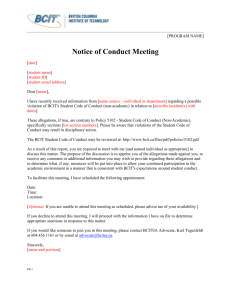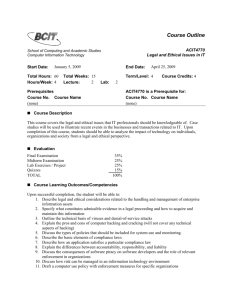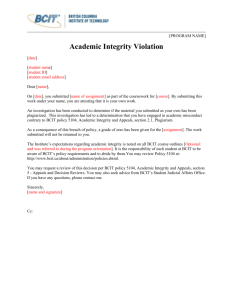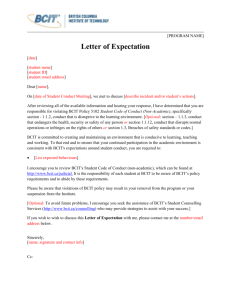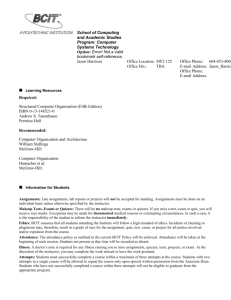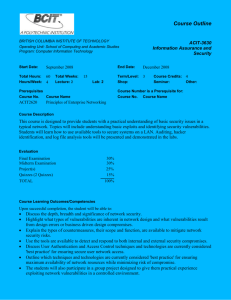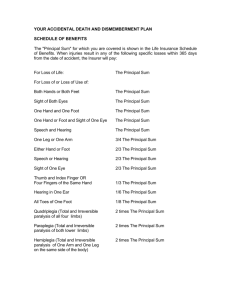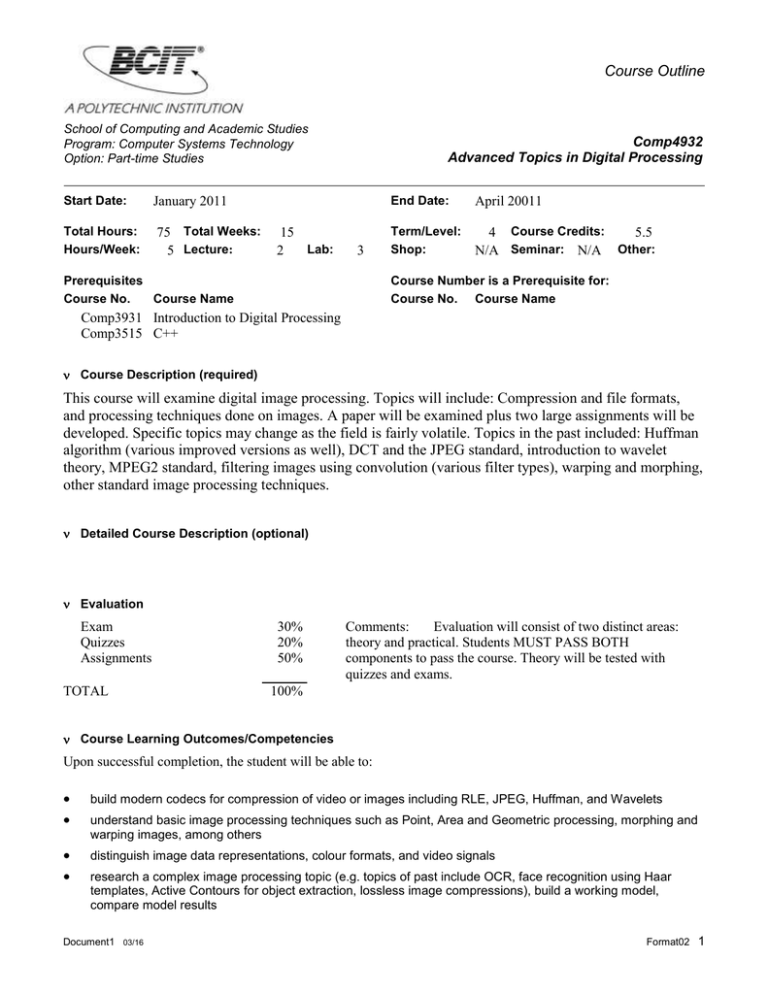
Course Outline
School of Computing and Academic Studies
Program: Computer Systems Technology
Option: Part-time Studies
Start Date:
January 2011
Total Hours:
Hours/Week:
75 Total Weeks:
5 Lecture:
15
Lab:
2
Comp4932
Advanced Topics in Digital Processing
3
Prerequisites
Course No.
Course Name
End Date:
April 20011
Term/Level:
Shop:
4 Course Credits:
5.5
N/A Seminar: N/A Other:
Course Number is a Prerequisite for:
Course No. Course Name
Comp3931 Introduction to Digital Processing
Comp3515 C++
Course Description (required)
This course will examine digital image processing. Topics will include: Compression and file formats,
and processing techniques done on images. A paper will be examined plus two large assignments will be
developed. Specific topics may change as the field is fairly volatile. Topics in the past included: Huffman
algorithm (various improved versions as well), DCT and the JPEG standard, introduction to wavelet
theory, MPEG2 standard, filtering images using convolution (various filter types), warping and morphing,
other standard image processing techniques.
Detailed Course Description (optional)
Evaluation
Exam
Quizzes
Assignments
TOTAL
30%
20%
50%
Comments:
Evaluation will consist of two distinct areas:
theory and practical. Students MUST PASS BOTH
components to pass the course. Theory will be tested with
quizzes and exams.
100%
Course Learning Outcomes/Competencies
Upon successful completion, the student will be able to:
build modern codecs for compression of video or images including RLE, JPEG, Huffman, and Wavelets
distinguish image data representations, colour formats, and video signals
understand basic image processing techniques such as Point, Area and Geometric processing, morphing and
warping images, among others
research a complex image processing topic (e.g. topics of past include OCR, face recognition using Haar
templates, Active Contours for object extraction, lossless image compressions), build a working model,
compare model results
Document1 03/16
Format02
1
Course Outline
Error! Reference source not found. Error! Reference source not found.
(cont’d.)
compare and measure various lossless and lossy compression algorithms
explain image and video compression standards
Verification
I verify that the content of this course outline is current.
Dennis Richards
December 15, 2010
Authoring Instructor
Date
I verify that this course outline has been reviewed.
Program Head/Chief Instructor
Date
I verify that this course outline complies with BCIT policy.
Dean/Associate Dean
Date
Note: Should changes be required to the content of this course outline, students will be given reasonable notice.
Document1 03/16
Format02
2
Course Outline
Error! Reference source not found. Error! Reference source not found.
(cont’d.)
Instructor(s)
Dennis Richards
Office Location: SW2-321
Office Hrs.:
TBA
Office Phone: 451-6940
E-mail Address: Dennis_Richards@bcit.ca
Learning Resources
Required:
Fundamentals of Multimedia, Ze-Nian Li, Mark S. Drew, Pearson/Prentice Hall
Recommended:
Compressed Image File Formats, John Miano, Addison Wesley
A Simplified Approach to Image Processing, Randy Crane, Prentice Hall (simple, easy to follow, gives code)
Or
Digital Image Processing 2nd ed., Rafael Gonzalez, Richard Woods, Prentice Hall (detailed, theory oriented, no
code but formulas)
Information for Students
(Information below can be adapted and supplemented as necessary.)
Assignments: Late assignments, lab reports or projects will not be accepted for marking. Assignments must be done on an
individual basis unless otherwise specified by the instructor.
Makeup Tests, Exams or Quizzes: There will be no makeup tests, exams or quizzes. If you miss a test, exam or quiz, you will
receive zero marks. Exceptions may be made for documented medical reasons or extenuating circumstances. In such a case, it
is the responsibility of the student to inform the instructor immediately.
Ethics: BCIT assumes that all students attending the Institute will follow a high standard of ethics. Incidents of cheating or
plagiarism may, therefore, result in a grade of zero for the assignment, quiz, test, exam, or project for all parties involved
and/or expulsion from the course.
Attendance: The attendance policy as outlined in the current BCIT Calendar will be enforced. Attendance will be taken at the
beginning of each session. Students not present at that time will be recorded as absent.
Illness: A doctor’s note is required for any illness causing you to miss assignments, quizzes, tests, projects, or exam. At the
discretion of the instructor, you may complete the work missed or have the work prorated.
Attempts: Students must successfully complete a course within a maximum of three attempts at the course. Students with two
attempts in a single course will be allowed to repeat the course only upon special written permission from the Associate Dean.
Students who have not successfully completed a course within three attempts will not be eligible to graduate from the
appropriate program.
Course Outline Changes: The material or schedule specified in this course outline may be changed by the instructor. If
changes are required, they will be announced in class.
Labs: Lab attendance is mandatory. Lab exercises are due at the end of the lab period.
I.D. Required in Examination Centres: Effective December 2000, in order to write exams, students will be required to
produce photo-identification at examination centres. Photo I.D. must be placed on the desk before an exam will be issued to the
student. The I.D. must remain in view on the desk while writing the exam, for inspection by invigilators. Students should bring
a BCIT OneCard or alternatively two pieces of identification, one of which must be government photo I.D. such as a driver’s
licence. Please see BCIT Policy #5300, Formal Invigilation Procedures.
Computer Use Policy: BCIT has an Institute-wide policy (#3501) pertaining to information technology and services and to
the resources available in support of the Institute mission. Computer Systems Technology students are expected to exercise the
highest degree of professionalism and ethical behaviour related to information technology. Violations of BCIT Policy #3501
Document1 03/16
Format02
3
Course Outline
Error! Reference source not found. Error! Reference source not found.
(cont’d.)
will result in disciplinary action which may include suspension or expulsion of students. Also refer to the Computer Systems
Technology Student Conduct Guidelines.
Assignment Details
Assignment #1: Morphing tool. The tool will use a transition morph, where the user provides two images,
the number of frames to create and the output will be a series of transitional frames from one image
(source) to another image (destination). The user draws on the source and destination images and the
control lines along with the number of transitional frames. After generating the transitional frames,
animate them SMOOTHLY showing the morphing. See outline for more details.
Assignment #2: You are to develop a working version of H.261 compression (simplified). For the JPEG
portion you must adhere to the JPEG standard except for the Entropy step where you may just apply RLE
to the entire quantized 8x8 block. For the motion vector calculations you may implement any of the three
algorithms discussed. Allow user to specify the value of p (search area) from 1 to 15. For simplification
your algorithm only needs to work with 2 video frames (passed in as bitmaps or jpeg images). The first
frame should be JPEGed, the second frame should use the motion vectors (using the first frame as the
reference frame) and the chosen value of p and apply your DCT/quantization&RLE to difference blocks.
Block size should be 8x8 (for simplification) for motion detection (8x8 for JPEG). RLE should be done in
a zig-zag pattern. You may count the DCT portion with the AC when RLE. Results of compression
performance should be added to status bar, use width*height*3 as original image size and the resulting
image size after compression. Both images must be stored (written to harddrive) as one using your own
format and be uncompressible after user opens your compressed 2-frame “video”. Marks awarded for
PROOF (via demo) of each step working (no marks for non-working coded steps).
Assignment#3- Paper: You are to implement the paper provided. Details to follow.
Document1 03/16
Format02
4
Course Outline
Error! Reference source not found. Error! Reference source not found.
(cont’d.)
Schedule
Week of/
Number
Outcome/Material Covered
Reference/
Reading
Assignment
1
Graphics and Image Data
representations
Colour in images & video
chpt3, 4
quiz
2
Point Processing, Area Processing,
Geometric Processing
notes
quiz
3
Morphing & Warping
notes
Morpher,
quiz
4
Image and video compressions
(excluding wavelets)
chpt 5, 7, 8.18.5, 9, 10, 11
Simplified
H.261 codec,
quiz
5
Wavelets
chpt. 8.6,8.7,8.8
quiz
6
Special topics – examining a paper
paper provided
implementation
of paper
(Project)
Due Date
CST Student Conduct Guidelines
The School of Computing and Academic Studies expects the highest level of professional conduct and ethical behaviour from
all students enrolled in Computer Systems Technology (CST) courses and programs.
All students are reminded of the following BCIT policies related to student conduct:
Policy 5002 Cheating and Plagiarism
www.bcit.ca/files/pdf/policies/5002.pdf
Policy 5002 Student Conduct
www.bcit.ca/files/pdf/policies/5002.pdf
Policy 3501 Responsible Use of Information Technology at BCIT
www.bcit.ca/files/pdf/policies/3501.pdf
CST students are especially reminded that the Computing and IT knowledge and skills acquired in the course of their studies
confer upon them, as with all IT professionals, a special responsibility to use this knowledge in a responsible, professional and
ethical manner.
Given that misuse of computer facilities at BCIT can have significant legal and/or economic impacts, upon evidence of any
violation of Policy 3501, the School may recommend immediate suspension, even for first offences.
By attending this course, every student has been made aware of these policies and the actions that will be taken. Please follow
the links provided, each student is responsible to read and comply with these policies.
Document1 03/16
Format02
5

